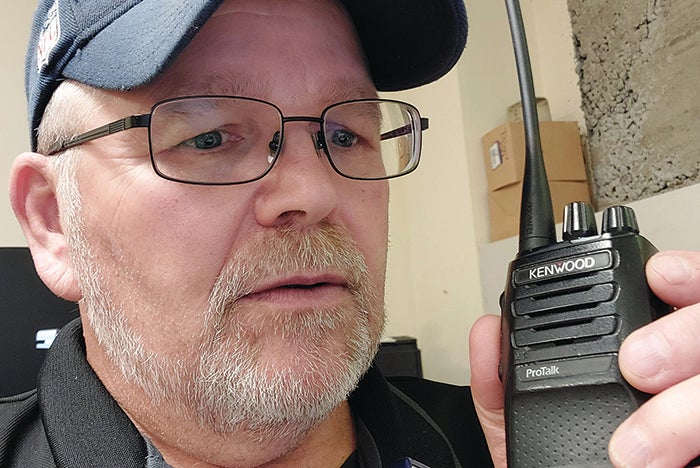Upgrade allows clear communication

Maintenance Supervisor Jim Waters (pictured) worked with a two-way radio retailer to upgrade the hospital’s communication tools.
Image courtesy of Jim Waters
The maintenance crew at University of Rochester Medical Center’s (URMC’s) Jones Memorial Hospital (JMH) in Wellsville, N.Y., is responsible for ensuring the infrastructure of the facility is functioning at all times. A health care facility with a power outage, poor air quality in the ventilation system or unchecked safety devices puts the safety of patients and hospital staff at risk. The team’s large number of responsibilities and critical functions make interdepartmental communications crucial to its operations.
As the maintenance supervisor at JMH, Jim Waters understands the importance of quick and efficient communication for his 10-person crew. However, in managing a multi-facility organization with some clinics spread as far as 10 miles apart, finding a solution that allows for instant communication presented challenges.
Waters and the staff at JMH have been using two-way radios for years, but as the team and its operations expanded, the communication range began to diminish. The analog-only radios also had no way to convert to future digital versions. Waters says having multichannel radios also became a necessity for the hospital, which includes multiple departments that need quick radio access.
“Two-way radios are an important tool for any health care facility since we are constantly communicating in big spaces with multiple teams,” Waters says. “You need a tool that can get your message or request out instantly.”
Waters also needed radios with an instant push-to-talk feature that would allow the team to quickly communicate on the status of jobs and other matters happening in or outside a health care facility.
“Hospitals are busy places, and our team does not have the time to individually call each and every person on the phone to get a message across,” Waters says. “We are constantly communicating with our maintenance team, the cleaning crews and hospital administration over multiple channels, and two-way radio push-to-talk communication allows us to instantly contact the relevant hospital team to update them on a job or let them contact us if they need help.”
Waters and his team also needed radios with a significant range that could communicate across all 10 clinics at JMH and the nearby hardware store that the hospital’s maintenance team frequents for parts.
Initially, Waters looked at a more expensive option, but before hitting the purchase button he consulted with two-way radio retailer HQ98 in Scottsdale, Ariz. After helping to assess the facility’s needs, HQ98 recommended the NX-P1300AUK 5-watt UHF radios from Kenwood.
The waterproof radios include a built-in emergency button, up to 64 talk channels and up to 15 hours of battery life. In addition, since Waters and his maintenance team cover a large medical facility, they also use a repeater to ensure they can effectively communicate across the entire medical campus.
“If you have multiple departments using two-way radios, you are going to want to give them their own channel so you don’t have too much cross conversation,” Waters says. “The administrative team, the maintenance department and the cleaning team all use two-way radios every day, and if each team did not have a dedicated channel it would be really difficult to communicate.”
Waters says the repeater is good for anyone looking to communicate long distances, and URMC Jones Memorial Hospital has some clinics spread out over 10 miles apart. It is a challenge just for radio signals to travel to certain floors in a single large building complex, so asking radio signals to travel through multiple walls over long distances is impossible without help. However, with the new solution, JMH’s maintenance team’s devices now have the signal strength to travel from clinic to clinic.
In the future, Waters hopes to purchase earpieces for his team to pair with the radios. An earpiece allows the different hospital teams to have more hands-free and private communication. Hands-free communication is helpful to employees who are constantly working with their hands and provides discretion for facility staff working to fix an urgent situation without panicking patients.
The new solution and upgrades give Waters’ team the constant communication it needs to efficiently run a top-of-the-line health care facility.




